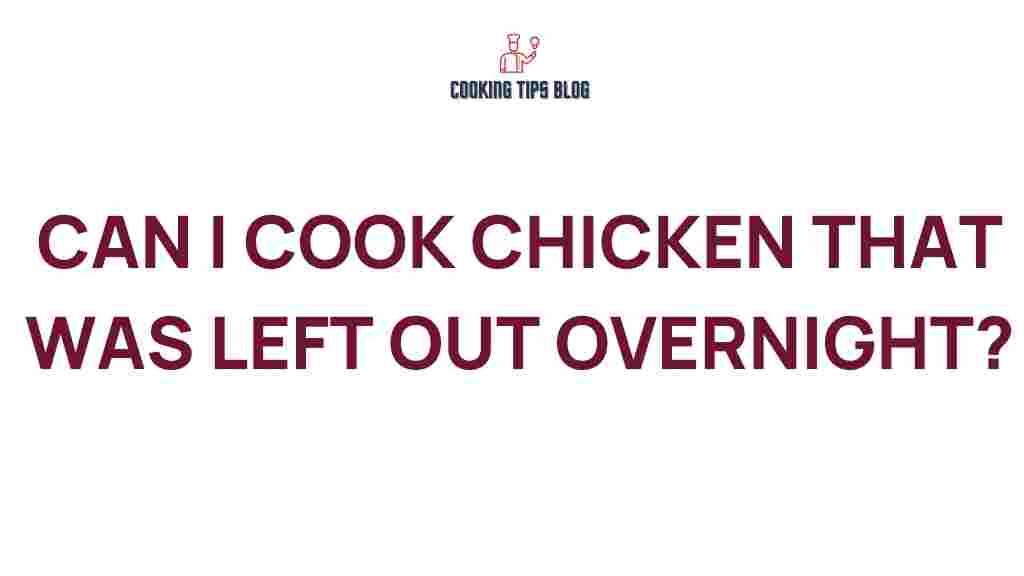Chicken Safety: The Risks of Cooking Chicken Left Out Overnight
When it comes to food safety, few topics are as critical as chicken safety. Whether it’s a family dinner or a casual meal prep, ensuring that chicken is handled properly is essential for health and well-being. One of the most common mistakes people make is leaving chicken out overnight. This article explores the risks associated with this practice, how to properly handle chicken, and what you need to know to keep your meals safe and enjoyable.
Understanding Chicken Safety
Chicken is a popular protein choice around the world, but it can harbor harmful bacteria if not stored correctly. The USDA recommends that perishable food, including chicken, should not be left out at room temperature for more than two hours. If the temperature exceeds 90°F, this time frame decreases to just one hour. Leaving chicken out overnight significantly increases the risk of foodborne illnesses caused by bacteria such as Salmonella and Campylobacter.
The Dangers of Leaving Chicken Out
When chicken is left out at room temperature, it enters the “danger zone,” which is between 40°F and 140°F. During this time, bacteria can multiply rapidly, leading to potential food poisoning. Here are some significant risks associated with cooking chicken left out overnight:
- Rapid Bacterial Growth: Bacteria can double in number every 20 minutes under ideal conditions.
- Foodborne Illness: Consuming contaminated chicken can lead to severe gastrointestinal issues.
- Compromised Flavor and Texture: Bacteria not only affect safety but can also ruin the taste and quality of the chicken.
Proper Handling and Storage of Chicken
To ensure chicken safety, proper handling and storage practices are crucial. Here’s a step-by-step process to follow:
Step 1: Purchase and Transport
When buying chicken, consider these tips:
- Check the sell-by date on the packaging.
- Choose chicken that is refrigerated or frozen.
- Transport the chicken in a cooler or insulated bag to maintain its temperature.
Step 2: Refrigeration
Once home, promptly refrigerate or freeze chicken:
- Refrigeration: Store chicken in the coldest part of your refrigerator at or below 40°F.
- Freezing: If not using chicken within a couple of days, freeze it for later use. Use freezer-safe bags to prevent freezer burn.
Step 3: Thawing Chicken Safely
Never thaw chicken on the counter. Instead, use one of the following safe methods:
- In the Refrigerator: Allow 24 hours for every 5 pounds of chicken.
- Cold Water Method: Submerge in cold water, changing the water every 30 minutes.
- Microwave: Use the defrost setting if you plan to cook it immediately afterward.
Step 4: Cooking Chicken
To ensure chicken safety during cooking:
- Cook chicken to an internal temperature of 165°F, as measured by a food thermometer.
- Never partially cook chicken, as this can allow bacteria to survive.
- Avoid cross-contamination by using different utensils and cutting boards for raw chicken and other foods.
Troubleshooting Tips for Safe Chicken Handling
Even with the best intentions, mishaps can occur. Here are some troubleshooting tips if you find yourself in a situation involving chicken that may have been left out:
What to Do If Chicken Was Left Out
If you accidentally left chicken out overnight, it’s crucial to assess the situation:
- Visual Inspection: Look for any signs of spoilage, such as an off smell or discoloration.
- Temperature Check: If the chicken has been above 40°F for more than two hours, discard it.
- When in Doubt, Throw It Out: It’s safer to discard questionable chicken than to risk foodborne illness.
Cooking Leftover Chicken Safely
If you have leftover cooked chicken that was stored properly, ensure it is reheated to an internal temperature of 165°F before consuming. Here are some tips for reheating:
- Use a food thermometer to check the temperature.
- Reheat chicken in the oven, microwave, or stovetop until steaming hot.
- Consume leftovers within three to four days to ensure safety.
Conclusion
Understanding chicken safety is crucial for anyone who cooks or consumes chicken. Leaving chicken out overnight poses significant health risks due to rapid bacterial growth and potential foodborne illnesses. Always prioritize proper handling and storage practices to keep your meals safe. If you ever find yourself in doubt about the safety of chicken, remember the motto: when in doubt, throw it out.
For more information on food safety, check out the USDA Food Safety and Inspection Service. And remember, for safe cooking practices, visit our cooking tips page for additional resources.
This article is in the category Healthy and created by Cookingtipsblog Team
